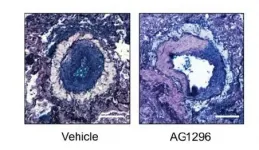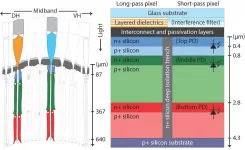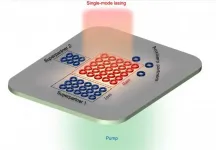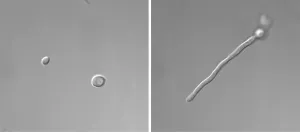From 4500 possibilities, one compound emerges as promising treatment for PAH
Team from Stanford and Cincinnati Children's uses patient-derived stem cells as screening tool to identify AG1296 as superior candidate for controlling dangerous pulmonary arterial hypertension
2021-05-05
(Press-News.org) One of the dangerous health conditions that can occur among premature newborns, children born with heart defects, and some others is pulmonary arterial hypertension (PAH).
Commonly mistaken for asthma, this condition occurs when blood vessels in the lungs develop excessive resistance to blood flow. This forces the heart's right ventricle to work harder, causing it to enlarge, thicken and further elevate blood pressure. While early treatment usually succeeds, the condition can become persistent and progressive, which can lead to heart failure and death.
The exact incidence and prevalence of PAH remains unclear, but reviews of patient registries in Europe have estimated that the condition occurs in nearly 64 of every 1 million children, including transient cases. So far, there is no cure.
Now a team of scientists at Stanford University and Cincinnati Children's report finding a potentially effective needle in a haystack.
"In this study, we screened a library of 4500 compounds at different stages of clinical development in eight different doses. Of the six compounds that improved cell survival, we identified the tyrosine kinase inhibitor AG1296 as the lead compound for further investigation," says Mingxia Gu, MD, PhD, lead author of a study published May 5, 2021, in Science Translational Medicine.
This compound has been available for research for several years but has not been approved for medical use. Its potential value as a PAH treatment emerged only after testing an entire library of compounds using several lines of induced pluripotent stem cells (iPSCs) grown to reflect the genetic signatures of actual patients with the condition.
The researchers found that AG1296 outperformed several other TKI inhibitors on a series of gene expression, cell signaling and mechanistic measures. Most importantly, the compound reversed key biomarkers of the disease in human cells and improved vascular function in animal models.
Center of Excellence
The Pulmonary Hypertension Clinic at Cincinnati Children's is one of eight pediatric centers in the nation to earn accreditation from the Pulmonary Hypertension Association (PHA) as a Pulmonary Hypertension Accredited Comprehensive Care Center.
Cincinnati Children's also hosts the PAH Biobank, an NIH/NHLBI funded resource of biological samples, genetic data, and clinical data for the PAH research community.
Next Steps
The use of human, PAH-specific stem cells as a drug screening platform reflects a crucial step forward, Gu says. In previous studies, about 90% of potential treatments that showed promise in animal studies failed to show benefits in human clinical trials.
"This is the first time for using iPSCs to screen for compounds for PAH, but people have been using similar strategies to screen for new therapy for other conditions," Gu says. "Overall, using patient-specific iPSCs for developing precision medicine is a new and promising field."
Launching a clinical trial for AG1296 likely will require a year or more of preparation and safety evaluations, Gu says. If a trial is launched, it could take a few more years to complete. Then an application process to seek approval from the US Food and Drug Administration would begin.
INFORMATION:
About the Study
This research was supported by grants from the National Institutes of Health (R01 HL122887, P01HL108797, R00 HL135258, U19 AI109662, U19 AI057229, and R01 AI125197); the Bill & Melinda Gates Foundation (OPP1113682); and the Department of Defense (W81XWH-18-1-0253 and
W81XWH-19-1-0235).
Learn more about pulmonary hypertension
[Attachments] See images for this press release:

ELSE PRESS RELEASES FROM THIS DATE:
2021-05-05
Inspired by the powerful eyes of the mantis shrimp, scientists have designed an imaging system that can distinguish between cancerous and healthy tissues during cancer surgery. The system accurately labeled tumors in mice and visualized lymph nodes near tumors in 18 patients undergoing surgery for breast cancer. With further development, the camera could help surgeons remove the marginal tumor tissues that can remain after unguided surgery, potentially lowering the risk of cancer relapse. It is critical for surgeons to remove as much tumor tissue as possible during surgery, but anywhere from 25% ...
2021-05-05
Machine learning algorithms can leverage vast amounts of consumer data, allowing automation of business decisions such as pricing, product offerings, and promotions. Airbnb, an online marketplace for vacation rentals and other lodging, created an algorithm-based smart-pricing tool that is free to all Airbnb hosts and allows hosts to set their properties' daily price automatically. A new study investigated the impact of Airbnb's algorithm on racial disparities among Airbnb hosts. Adopting the tool narrowed the revenue gap between White and Black ...
2021-05-05
An Austrian-American research team (University of Vienna, Department Evolutionary Anthropology and Harvard Medical School, Department of Genetics), in collaboration of Hungarian experts from Eötvös Loránd University, has developed a new method that allows the almost non-destructive extraction of genetic material from archaeological human remains. The method allows anthropologists, archaeologists and archaeogeneticists to avoid the risk of serious damage to artefacts of significant scientific and heritage value, which can then be fully examined in future research.
Bioarcheological ...
2021-05-05
The first mental health study of Black communities in Canada has found the majority of Black Canadians display severe depressive symptoms - women, even more so - with racial discrimination confirming the appearance of these signs for nearly all.
The study, published in Depression and Anxiety, discovered nearly two-thirds (65.87 percent) of surveyed participants reported severe depressive symptoms. Higher rates were found among women; those who are employed; those born in Canada; and nearly all who have been experienced high racial discrimination.
"Rates of depressive symptoms among Black individuals are nearly six times the 12-month prevalence reported for the general population in Canada," says ...
2021-05-05
Granular materials, such as sand and gravel, are an interesting class of materials. They can display solid, liquid, and gas-like properties, depending on the scenario. But things can get complicated in cases of high-speed vehicle locomotion, which cause these materials to enter a "triple-phase" nature, acting like all three fundamental phases of matter at the same time.
As reported in the April 23, 2021 issue of the journal Science Advances, a team of engineers and physicists from the Massachusetts Institute of Technology (MIT) and Georgia Institute ...
2021-05-05
The field of photonics aims to transform all manner of electronic devices by storing and transmitting information in the form of light, rather than electricity. Beyond light's raw speed, the way that information can be layered in its various physical properties makes devices like photonic computers and communication systems tantalizing prospects.
Before such devices can go from theory to reality, however, engineers must find ways of making their light sources -- lasers -- smaller, stronger and more stable. Robots and autonomous vehicles that use LiDAR for optical sensing and ranging, manufacturing and material ...
2021-05-05
Scientists are certain that dark matter exists. Yet, after more than 50 years of searching, they still have no direct evidence for the mysterious substance.
University of Delaware's Swati Singh is among a small group of researchers across the dark matter community that have begun to wonder if they are looking for the right type of dark matter.
"What if dark matter is much lighter than what traditional particle physics experiments are looking for?" said Singh, an assistant professor of electrical and computer engineering at UD.
Now, Singh, Jack Manley, a UD doctoral student, and collaborators at ...
2021-05-05
BUFFALO, N.Y. -- You might call Candida albicans a shape-shifter: As this fungus grows, it can multiply as single, oval-shaped cells called yeast or propagate in an elongated form called hypha, consisting of thread-like filaments.
This dual nature can help the pathogen survive in the body, where it can cause disease, including dangerous hospital-acquired infections.
But how does this switching ability occur?
New research identifies one factor that may contribute. In a study that will be published on May 5 in the journal mSphere, University at Buffalo biologists Guolei Zhao and Laura Rusche report that a protein called Sir2 may facilitate C. albicans' transition from ovoid yeast ...
2021-05-05
WHAT:
A team of researchers funded by the National Institutes of Health has developed a new ultrasound technique to monitor the placenta for impaired fetal blood flow early in pregnancy. The technique, which uses conventional ultrasound equipment, relies on subtle differences in the pulsation of fetal blood through the arteries at the fetal and placental ends of the umbilical cord, potentially enabling physicians to identify placental abnormalities that impair fetal blood flow and, if necessary, deliver the fetus early. Like current ultrasound techniques, the new technique can also detect impaired flow of maternal blood through the placenta.
The study was conducted by John G. Sled, Ph.D., of The Hospital for Sick Children in Toronto, ...
2021-05-05
Magnetic Resonance Imaging (MRI) images are usually meant to be static. But now, researchers from Mātai Medical Research Institute (Mātai), Stevens Institute of Technology, Stanford University, the University of Auckland and other institutions, report on an imaging technique that captures the brain in motion in real time, in 3D and in stunning detail, providing a potential diagnostic tool for detecting difficult-to-spot conditions such as obstructive brain disorders and aneurysms - before they become life threatening.
The new technique, called 3D amplified ...
LAST 30 PRESS RELEASES:
[Press-News.org] From 4500 possibilities, one compound emerges as promising treatment for PAH
Team from Stanford and Cincinnati Children's uses patient-derived stem cells as screening tool to identify AG1296 as superior candidate for controlling dangerous pulmonary arterial hypertension






